




Mould can easily accumulate in washing machine drawers, causing unpleasant odours and potentially affecting the cleanliness of your laundry. However, with the right techniques and cleaning products, you can effectively remove mould and prevent its return. In this article, we will share expert cleaning tips to help you eliminate mould from your washing machine drawer.
Step 1: Remove the drawer and clean it separately. Start by removing the detergent drawer from your washing machine. Most detergent drawers can be easily pulled out or have a release button. Once removed, use a mild detergent and warm water to clean the drawer thoroughly. Scrub the compartments with a soft brush or toothbrush to remove any dirt or residue.
Step 2: Use a mould remover or natural alternative. Mould removers specifically designed for washing machine parts are available in supermarkets and hardware stores. Follow the instructions on the product, ensuring proper ventilation and safety precautions. Alternatively, you can use natural alternatives such as white vinegar or baking soda. Mix equal parts vinegar and water or create a paste using baking soda and water. Apply the solution to the affected areas of the drawer and let it sit for a few minutes before scrubbing away the mould.
Step 3: Rinse and dry the drawer. After cleaning the drawer with a mould remover or natural alternative, rinse it thoroughly with clean water. Make sure to remove all traces of the cleaning solution to prevent any possible damage to your laundry. Once rinsed, dry the drawer completely before placing it back into the washing machine.
Expert Tip: To prevent future mould growth, leave the detergent drawer open after each use to allow it to dry completely. This will help prevent moisture buildup and discourage the growth of mould and mildew.
By following these expert cleaning tips, you can effectively remove mould from your washing machine drawer and ensure a clean and odour-free laundry experience. Remember to always read and follow the instructions on any cleaning product you use, and consider using natural alternatives for a more eco-friendly approach.
Step-by-Step Guide to Remove Mould from the Washing Machine Drawer
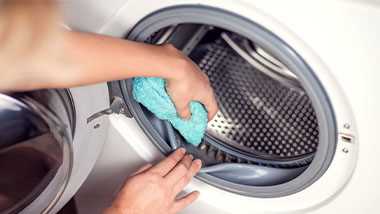
1. Empty the drawer
Start by removing any clothes or detergent that may be present in the washing machine drawer. Empty it completely to ensure easy access to the mouldy areas.
2. Prepare a cleaning solution
- Mix equal parts of white vinegar and water in a bowl or bucket. The vinegar’s acidity will help kill the mould and remove any unpleasant odours.
- If the mould is stubborn, add a few drops of mild dish soap to the mixture. This will create a soapy solution that provides additional cleaning power.
3. Remove the drawer
In most washing machines, the drawer can be easily removed by pulling it outwards. Check your washing machine’s manual if you are unsure how to remove the drawer. Place the drawer on a flat surface for cleaning.
4. Scrub the drawer
- Dip a scrub brush or toothbrush into the cleaning solution.
- Scrub the affected areas of the drawer thoroughly. Pay extra attention to any visible mould or buildup.
- For stubborn mould, let the cleaning solution sit on the affected areas for a few minutes before scrubbing.
- Rinse the drawer with water to remove any remaining cleaning solution and loosened mould.
5. Dry the drawer
- Use a clean, dry cloth or towel to remove excess moisture from the drawer.
- Place the drawer in a well-ventilated area to air dry completely. This will prevent any remaining moisture from promoting the growth of new mould.
- Avoid placing the drawer back into the washing machine until it is completely dry.
6. Clean the washing machine
While the drawer is drying, take the opportunity to clean the inside of the washing machine. Wipe down the interior with a cloth dampened in the cleaning solution used for the drawer. Pay attention to any seals or crevices where mould may be present. Rinse the washing machine thoroughly after cleaning.
7. Regular maintenance
- To prevent future mould growth, remove and clean the washing machine drawer at least once a month.
- Keep the drawer and the inside of the washing machine dry between uses by leaving the door open and wiping down any excess moisture.
By following these steps, you will be able to effectively remove mould from your washing machine drawer and maintain a clean and odour-free laundry appliance.
Understanding the Risks of Mould in the Washing Machine
Mould is a common problem in many households, but it can also pose risks when it starts growing in the washing machine. The warm and damp environment of the washing machine drawer provides the perfect conditions for mould to thrive.
Here are some of the risks associated with mould in the washing machine:
1. Health Risks
Mould releases spores into the air, which can be inhaled and cause a variety of health issues. Some people may be more sensitive to mould than others, and prolonged exposure can lead to respiratory problems, allergies, and skin irritations.
2. Foul Odors
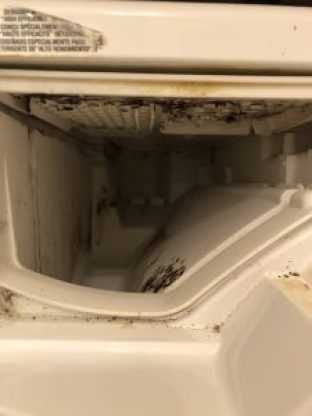
Mould in the washing machine can produce unpleasant odors that can transfer to your clothes. This can be especially problematic if you have sensitive skin or if the smell lingers even after washing.
3. Contamination of Clothing
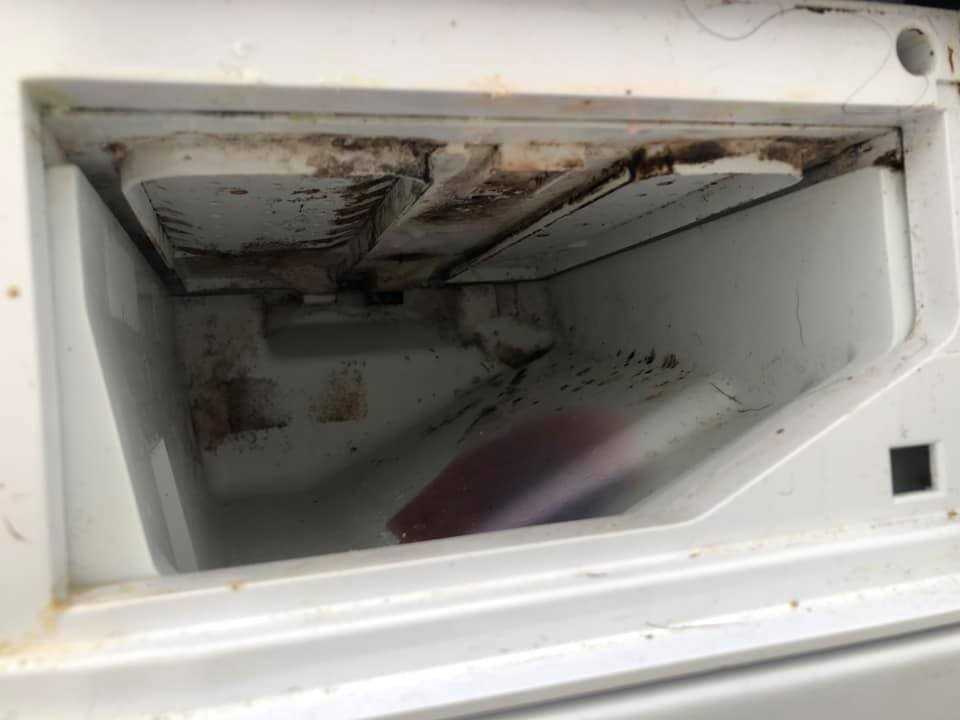
If mould is present in the washing machine, it can transfer to your clothes during the washing process. This can result in stains, discoloration, and an overall decrease in the lifespan of your garments.
4. Damage to the Washing Machine
Mould growth can damage the washing machine, particularly the rubber seals and gaskets. This can lead to leaks, reduced performance, and costly repairs or replacements.
5. Increased Energy Consumption
When mould is present in the washing machine, it can affect its efficiency and increase energy consumption. This is due to the machine having to work harder to achieve the desired results, leading to higher electricity bills.
It is essential to regularly clean and maintain your washing machine to prevent mould growth and mitigate these risks. By following expert cleaning tips, you can keep your washing machine mould-free and ensure the longevity of your machine and clothing.
Essential Tools and Materials for Cleaning a Mouldy Washing Machine Drawer
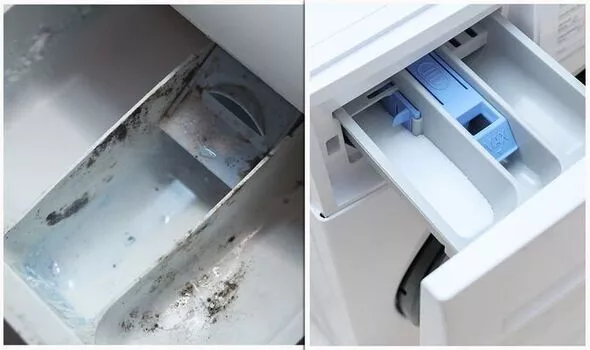
Tools:
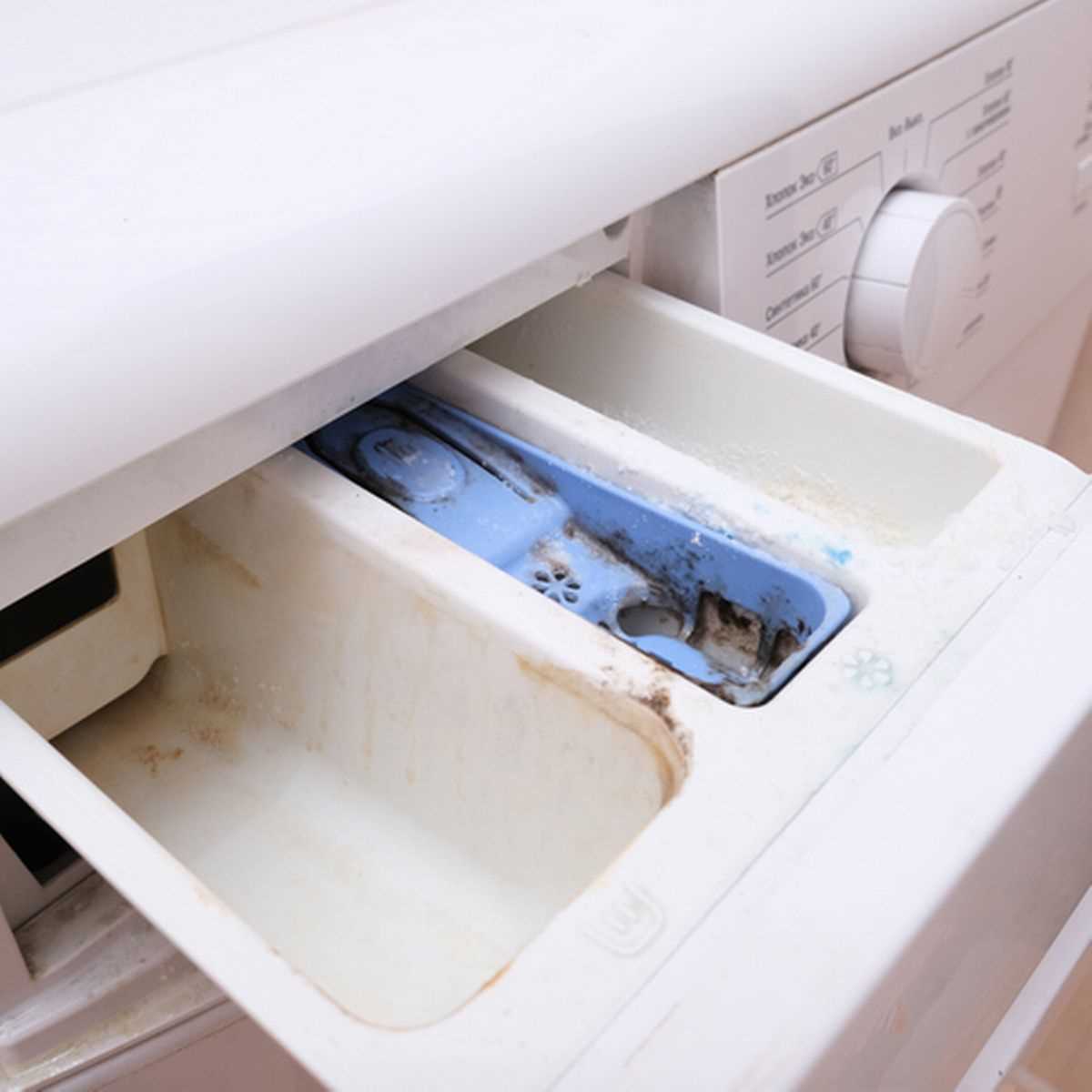
- Cleaning gloves
- Protective eyewear
- Old toothbrush or small scrub brush
- Microfiber cloth or sponge
- Cotton swabs
- Long-handled brush or flexible drain cleaning brush
Materials:

- Vinegar
- Baking soda
- Hot water
- Disinfectant cleaner
- Lemon juice
Note: Make sure to read and follow the instructions and warnings on all cleaning products and tools before use.
When cleaning a mouldy washing machine drawer, you’ll need a few essential tools and materials to effectively remove the mould and prevent its recurrence. Here’s a list of what you’ll need:
- Cleaning gloves: Protect your hands from any chemicals or bacteria while cleaning.
- Protective eyewear: Shield your eyes from any potential splashes or spray while cleaning.
- Old toothbrush or small scrub brush: Use this to scrub away any stubborn mould or residue.
- Microfiber cloth or sponge: Wipe away the cleaning solution and mould from the washing machine drawer.
- Cotton swabs: Reach into tight corners and crevices to ensure complete cleaning.
- Long-handled brush or flexible drain cleaning brush: Use this to clean the tubes and drains connected to the washing machine drawer.
As for the cleaning materials, here are the essentials:
- Vinegar: A natural, acidic cleaner that helps kill mould and remove stains.
- Baking soda: A versatile, non-toxic cleaner that helps absorb odours and scrub away grime.
- Hot water: Dilute and activate the cleaning agents for a more effective clean.
- Disinfectant cleaner: Use a commercial disinfectant cleaner for additional sanitization.
- Lemon juice: A natural cleaning agent that helps remove mould and freshen the drawer.
With these essential tools and materials on hand, you’ll be well-equipped to tackle the mould problem in your washing machine drawer and keep it clean and fresh.
Preparation: Emptying and Removing the Washing Machine Drawer
Before you begin the process of removing mould from your washing machine drawer, it is important to prepare by emptying and removing the drawer. Follow these steps:
- Turn off the washing machine: Make sure that the washing machine is turned off and unplugged from the power source to avoid any accidents.
- Empty the drawer: Start by removing all items from the washing machine drawer. This includes any detergent, softener, or other cleaning products that may be stored there.
- Inspect the drawer: Take a moment to inspect the drawer for any visible signs of mould. Look for black or green patches or any unpleasant odours.
- Remove the drawer: Depending on the make and model of your washing machine, you may need to press a release button or lever to remove the drawer. Refer to your washing machine manual for specific instructions.
- Clean the drawer: Once the drawer is removed, give it a thorough cleaning. Use a mixture of warm water and mild detergent to scrub away any mould or residue. Pay special attention to the corners and crevices.
By emptying and removing the washing machine drawer before starting the mould removal process, you ensure that the area is clean and ready for treatment. This will help to ensure optimal results and prevent the spread of mould to other areas of the washing machine.
The Cleaning Process: Removing Mould from the Washing Machine Drawer
Step 1: Safety Precautions
Before starting the cleaning process, it’s important to take some safety precautions:
- Make sure the washing machine is unplugged before handling any parts of the machine.
- Wear protective gloves to prevent any potential skin irritation or allergic reactions to cleaning products.
- Work in a well-ventilated area to avoid inhaling any fumes.
Step 2: Remove the Drawer
The first step in cleaning mould from the washing machine drawer is to remove the drawer itself. Follow these steps:
- Gently pull the drawer towards you until it stops.
- Locate the release mechanism or button on the so-called detergent dispenser.
- Press or pull the release mechanism to detach the drawer from the machine.
- Once the drawer is detached, inspect it for any visible mold or mildew.
Step 3: Clean the Drawer
Now that you have removed the drawer, it’s time to clean it thoroughly:
- Fill a sink or basin with warm water and add a small amount of mild detergent.
- Submerge the drawer in the soapy water and use a soft brush or cloth to scrub away any visible mold or mildew.
- Rinse the drawer thoroughly with clean water to remove any soap residue.
- Allow the drawer to air dry completely before reattaching it to the washing machine.
Step 4: Clean the Dispenser Cavity
While the drawer is drying, it’s time to clean the dispenser cavity:
- Inspect the dispenser cavity for any visible mold or mildew.
- Use a damp cloth or sponge to wipe away any visible mold or mildew.
- If necessary, use an old toothbrush dipped in a mixture of equal parts water and vinegar to scrub away stubborn mold or mildew.
- Rinse the dispenser cavity with clean water to remove any residue.
Step 5: Reassemble and Prevent Future Mold
Once both the drawer and dispenser cavity are clean, it’s time to reassemble the washing machine:
- Slide the drawer back into the correct position in the washing machine.
- Ensure that the drawer is securely attached and properly aligned with the machine.
- Before using the machine, run an empty cycle with hot water and a cup of white vinegar to kill any remaining mold spores and prevent future mold growth.
- After each use, leave the drawer and door of the washing machine open to allow air circulation and prevent moisture buildup.
By following these steps, you can effectively remove mold from your washing machine drawer and prevent future mold growth. Remember to regularly clean and maintain your washing machine to ensure its optimal performance and prolong its lifespan.
Aftercare and Preventive Measures to Avoid Mould in the Washing Machine Drawer
Mould in the washing machine drawer can be a recurring issue if proper aftercare and preventive measures are not taken. Here are some steps you can follow to avoid mould growth in your washing machine drawer:
1. Clean the Drawer Regularly
One of the most important preventive measures is to clean the washing machine drawer regularly. After each wash, remove the drawer and rinse it with warm water to remove any detergent residue. Use a mild detergent and a soft brush to scrub away any visible mould or grime. Rinse thoroughly and dry the drawer before putting it back in the machine.
2. Leave the Drawer Open

After each wash, leave the washing machine drawer open to allow air circulation and prevent moisture buildup. This will help to discourage mould growth and keep the drawer clean and dry.
3. Use Liquid Detergent
Powdered detergents can often leave residue in the washing machine drawer, contributing to mould growth. Consider switching to liquid detergent, as it is less likely to build up and cause mould problems.
4. Avoid Overloading the Machine
Overloading the machine can lead to poor water drainage, which can create a humid environment inside the washing machine drawer. Make sure to follow the manufacturer’s recommendations for load sizes and avoid overloading the machine.
5. Regularly Clean the Seal
The rubber seal around the washing machine door can also be a breeding ground for mould. Regularly clean the seal with a mixture of water and vinegar, or a mild bleach solution, to prevent mould growth. Wipe it dry after cleaning to avoid moisture buildup.
6. Run a Hot Cycle with Vinegar

Once a month, run an empty hot cycle with a cup of white vinegar to help kill any mould spores that may be present in the washing machine drawer. This will also help to remove any detergent buildup and keep the machine clean.
7. Inspect and Maintain the Machine
Regularly inspect the washing machine for any leaks or signs of water damage. Fix any issues immediately to prevent mould growth. Additionally, perform regular maintenance tasks, such as cleaning the filter and ensuring proper drainage, to keep the machine functioning properly and reduce the risk of mould.
By following these aftercare and preventive measures, you can avoid mould growth in your washing machine drawer and ensure clean and fresh laundry with each wash.
FAQ
What is the best way to remove mould from the washing machine drawer?
The best way to remove mould from the washing machine drawer is to mix equal parts of white vinegar and warm water in a spray bottle. Spray the mixture onto the mouldy areas and let it sit for about 15 minutes. Then, use a soft-bristle brush to scrub away the mould. Rinse the drawer thoroughly with water and wipe it dry before using the washing machine again.
Can I use bleach to remove mould from the washing machine drawer?
No, it is not recommended to use bleach to remove mould from the washing machine drawer. Bleach can be too harsh and may damage the plastic parts of the drawer. It is better to use a milder solution like white vinegar and warm water, as it is effective in killing mould and is safe for the washing machine.
How often should I clean the washing machine drawer to prevent mould growth?
It is recommended to clean the washing machine drawer at least once a month to prevent mould growth. Regular cleaning will help remove any built-up residue and moisture that can contribute to mould growth. Additionally, it is important to leave the drawer open after each use to allow it to fully dry and prevent the growth of mould.
What are some signs that there is mould in the washing machine drawer?
Some signs that there may be mould in the washing machine drawer include a musty or unpleasant odour coming from the drawer, black or greenish spots or patches on the drawer, or an increase in allergies or respiratory issues when using the washing machine. If you notice any of these signs, it is important to clean the drawer thoroughly to remove the mould.











